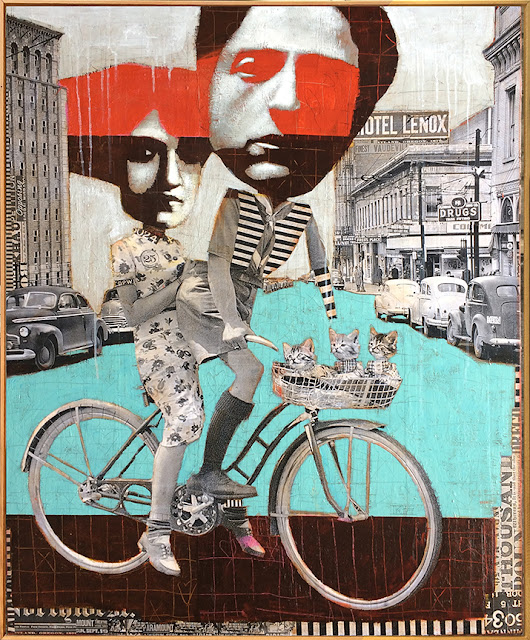Some of you have never seen my work in person. But even those of you who have, it can be difficult for people to tell how I make my art using collage. Often people don’t realize it is collage at all.
There are many ways to make collage art. I would organize it into two main techniques:
1. Cutting up and combining recognizable found images
2. Using colored paper as a form of paint, building an image similar to the way a pointillist uses dots.
Many artists use some combination of the two. Each combination of techniques has its pluses and minuses, and lends itself to different intents. Borrowed imagery tends to be more conceptual, because it makes us think about the imagery in a different way. Using colored paper as paint tends to be more formal or aesthetic.
Although the deep history of collage is ancient, the modern concept of collage probably started with Georges Braque, in 1914 (though some credit his buddy Pablo Picasso with this)
 |
| Georges Braque, Still Life on a Table Gillette, 1914 |
Braque first added wall paper with a wood grain print to his cubist drawings as a sort of visual pun. The collaged paper also functioned as a color to support the abstract cubist design.
 |
| Georges Braque, Mandoline, 1914 |
He went on to use found objects and images such as text from newspapers and advertisements. Can you believe these darn things are over 100 years old?
A good example of an artist who uses found images is Hannah Hoch, who was a pioneer of the art form and used found imagery to create art that made social commentary.
 |
| Hannah Hoch, Da-Dandy, 1919 |
 |
| Hannah Hoch, Untitled, 1930 |
In the 1960's, Robert Rauschenberg combined found images with silk screen, paint and drawing.
 |
| Robert Rauschenber, Skyway, 1964 |
 |
| Robert Rauschenberg Mirthday Man, 1997 |
A couple of contemporary artists who do similar things are Ellen Gallager, and fellow Portland artist, Karen Wippich!
 |
| Ellen Gallagher, Getting Hair Did, 2005? |
Kurt Schwitters is a good, early example of an artist who used paper primarily as one would use paint, to create abstract designs. Although he did use text and photographic images, they were used as color, value and texture, rather than for conceptual references. (He was also an early developer of installation art.)
 |
| Kurt Schwitters, Fur Moholy, 1934 |
 |
| Kurt Schwitters, Santa Claus, 1922 |
Many collage artists used found images in combination with using colored paper as a form of paint. Romare Bearden was a master of this, using photographic images to create narrative and reference, mixed with pure colored paper to support the formal aspects of the picture.
 |
| Romare Bearden, House in Cotton Field |
 |
| Romare Bearden, Springway, collage on paperboard 1964 |
Finally, some artists use colored paper exclusively, with no found images, to build a picture from the ground up. This is the technique I use, and Romare Bearden also used this technique in his "Black Odyssey" series.
 |
| Romare Bearden, The Water Nymph, 1970's |
At times I will also use text, but in the manner that Schwitters did, simply as color and texture.
Finally, there is contemporary encaustic art, which often uses found imagery embedded in layers of wax, creating an atmospheric, layered affect.
I don't tend to use borrowed imagery because, frankly, my mind doesn't seem to work that way, and I just get all confused while I am doing it. I have chosen to do collage because cutting paper forces me to simplify shapes in a way that makes my art stronger. But who knows what direction my art will eventually go????

















2 comments:
This is a great post on collage. I'm going to share it on Fb as soon as I can scratch my self. this abundant art show thing is time consuming. added to poetry performances and getting ready for two group shows, i'm exhausted.
Yes, the Abundant Artist Challenge is challenging! Good luck with it. Your video inspired me to make videos, too. They are on facebook, not instagram. Take care!
Post a Comment